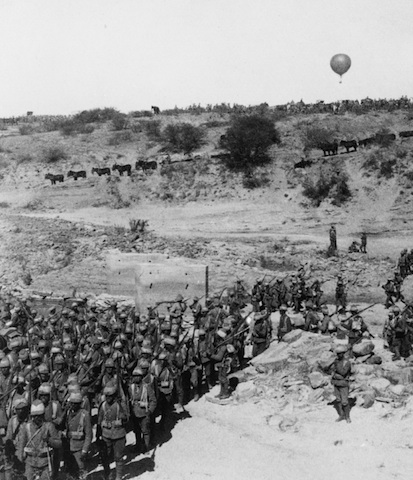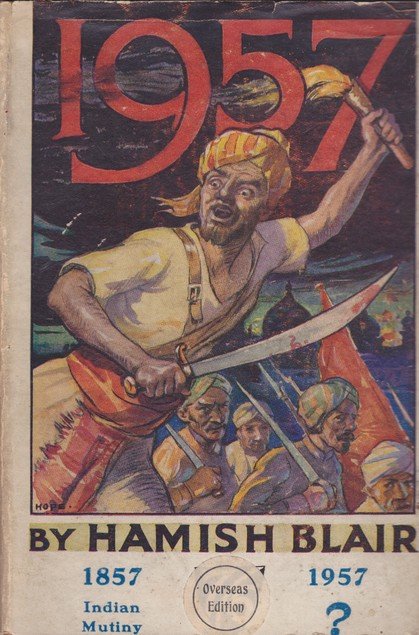This story turned up on the urban legends website Snopes recently:
Another enemy decoy, built in occupied Holland, let to a tale that has been told and retold every since by veteran Allied pilots. The German “airfield,” constructed with meticulous care, was made almost entirely of wood. There were wooden hangers, oil tanks, gun emplacements, trucks, and aircraft. The Germans took so long in building their wooden decoy that Allied photo experts had more than enough time to observe and report it. The day finally came when the decoy was finished, down to the last wooden plank. And early the following morning a lone RAF plane crossed the Channel, came in low, circled the field once, and dropped a large wooden bomb.
Did this really happen? Snopes quite reasonably concludes that ‘we can’t find reason to classify it as anything but fictional’, for several reasons – for example, wouldn’t it make sense to let the enemy think that their deception is working? I couldn’t find anything about a wooden bomb incident in any books on military deception in the Second World War.
The above quote is from Seymour Reit, Masquerade: The Amazing Camouflage Deceptions of World War II (New York: Hawthorn, 1978).
From Jasper Maskelyne: Master of Make-Believe:
Maskelyne sets up a dummy airfield which is soon bombed by the Italians. He repairs the damage and the next week there is a second attack, but the bombs land with a mysterious thump and fail to explode. They are dummy bombs and have obscene messages scrawled on them.
Maskelyne later learns that the retaliatory raid was carried out by Balbo, a famous test pilot before the war, the Italian equivalent of Lindbergh. Shortly afterwards Balbo dies mysteriously in an accident on takeoff (perhaps fired upon by his own air defences?).
Maskelyne was a British stage magician; the quote is a paraphrase from his (ghost-written?) memoirs, Magic – Top Secret (1949). Supposedly, during the Second World War he was involved in setting up elaborate decoys and deceptions in North Africa order to fool the Italians and Germans – a fake Alexandria harbour was one such scheme. The above link notes that Italo Balbo wasn’t killed while taking off down and more importantly, died long before Maskelyne even reached North Africa.
Also noted on that page is the following version of the wooden bomb story (no source is given):
Even Donovan, the head of America’s OSS, is said to have forwarded the following intelligence extract to President Roosevelt : “For months, Berlin has been camouflaging its streets, squares , parks and lakes to confuse Allied fliers,” reported Donovan. “All of Unter der Linden is now covered with giant colored nets under which the traffic moves… A simulated village has been erected in the center of the lake, of painted canvas on thin laths. To show contempt for this German effort at camouflage , a single RAF plane flew over the ‘village’ last night and dropped one wooden bomb.”
That story is hard to date; Donovan became head of the OSS in July 1941; the reference to “Allied fliers” suggests that the US was in the war and probably that its own bombing offensive had begun, so after mid-1942. But it’s clearly nonsense anyway: it would take a lot more to hide Berlin than hiding the traffic! And RAF night bombing wasn’t exactly accurate enough to be able to contempuously drop a bomb on a target as small as a village.
The Air Force Museum Foundation regales us with the following version, heard by the author, George R. Kiare (apparently an American veteran of the bombing campaign himself):
Another method of protecting an operational base that had been relocated involved building what appeared to be a new base some distance away. The service installations for the base were constructed of flimsy wood and the fake runway marked out in the proper dimensions. The builders took care to camouflage their wooden structures for the altitude at which Allied aircraft were likely to fly over them during normal operations. Work during World War II (and perhaps before) had shown that when properly designed, simple dummy structures on the ground can appear very realistic, shadows and all, when viewed from particular altitudes. From certain other altitudes, however, this effect can be lost and the structures seen for what they are. (I have observed this effect myself in a flyover, at two different altitudes, of a camouflaged base in Nebraska during World War II.)
The German planners hoped that their wooden air base would divert enemy fighters from the real base and might also tempt Allied strategists to send bomber crews to destroy it. Raids could subject bomber crews to fighter and anti-aircraft attack and, in the bargain, provide a good laugh for the winners of this wartime game. Such bogus bases could, of course, be cheaply and easily rebuilt after an attack.
Success in this game depended on Allied aircraft flying over the wooden base at or near the desired altitude. According to the tale told to me, a British pilot flying a “Mosquito” reconnaissance plane (ironically, a wooden aircraft itself) happened by the base during a phase of construction that aroused his suspicion. He was flying at a level and on a course which led him to do some cautious nosing about, which he reported on his return to England. He then received gleeful permission from his superiors to fly near the base subsequently to confirm what was going on, being careful to avoid both German suspicion and attack by Luftwaffe fighters and antiaircraft guns. When the Germans finished building the wooden base, he was allowed to fly directly over it in his Mosquito-at considerable risk of being shot down-and drop wooden bombs on it.
This version could have been told any time after late 1941 (when the Mosquito entered service). The language used gives some clues as to what the story meant to Kiare at least: the Germans would get a ‘good laugh’ out of luring Allied bombers to the wrong target, while the Mosquito pilot’s superiors gave him ‘gleeful permission’ to drop the wooden bomb. Kiare suggests that the British and the Germans took ‘special satisfaction’ in tricking each other.
The last version I found was this one at the 207 Squadron RAF Assocation website:
I had a small house in the village of Gottechain, from which I went to work as an agricultural worker on the airfield of Beauvechain. Of course at the same time I was noting what was going on, passing the information each week, how many aeroplanes etc. This was microphotographed and sent to England. One day, I noted that they had put dummy wooden aeroplanes on the runways. Five days later, the RAF let them know they knew their game, by dropping wooden bombs … !
This sounds like a primary source! The reference given is Vera Lynn with Robin Cross and Jenny de Gex, Unsung Heroines: The Women who won the War (London: Sidgwick & Jackson, 1990), 125 (I took the above quote from here, as the web version had a few typos). It would seem to be from an interview with Marie Eugénie Jadoul, who was a member of the Belgian intelligence network, Zero. She doesn’t actually say she saw the wooden bombs dropped, but as she was a labourer at the airfield and was collecting intelligence about it, it’s reasonable to infer that she was in a position to know. She may even have helped clean up the mess! On the other hand, the date of the incident is not given (except that it was before July 1944), and there is no indication of where recordings or transcripts of the interview have been deposited. But who am I to question Dame Vera?
So, it looks like the wooden bomb incident may have happened after all. But … Snopes also gives a very early source for the story: the diary of the American journalist William Shirer, who was based in Berlin during the early war years. He recorded the following variant in his entry for 27 November 1940:
X tells me a funny one. He says the British intelligence in Holland is working fine. Both sides in this war have built a number of dummy airdromes and strewn them with wooden planes. X says the Germans recently completed a very large one near Amsterdam. They lined up more than a hundred dummy planes made of wood on the field and waited for the British to come over and bomb them. Next morning the British did come. They let loose with a lot of bombs. The bombs were made of wood.
There’s no suggestion here that X had first-hand knowledge of any such incident, it sounds like just another wartime rumour. But it’s interesting that the story is placed in Holland, since Jadoul’s version took place in Belgium … not a million miles away. The location might have gotten mixed up in the retelling. If Shirer and Jadoul are referring to the same incident, then it must have happened some time between May (the fall of Belgium) and 27 November 1940 – probably more likely towards the end of that period, as the rumour presumably referred to a recent incident; also I guess it would take a few months at least, to set up a resistance organisation to relay information to Britain.
Looking through Martin Middlebrook and Chris Everitt, The Bomber Command War Diaries: An Operational Reference Book, 1939-1945 (Harmondsworth: Viking, 1985), there’s no mention of Beauvechain (let alone wooden bombs!) But there are indeed a number of raids on Belgian targets, including airfields – for example, on the night of 1/2 November, 81 aircraft were dispatched to bomb German cities and ‘airfields in Belgium, Holland and France’. Of course, it’s possible that dropping wooden bombs might not be the sort of operation that HQ would be told about, so it’s interesting to read that on 26 November (the day before Shirer’s diary entry), two Blenheims set out for Belgian airfields, but ‘turned back’ before reaching their target. Maybe that’s just what Bomber Command was told …
Well, that’s about as far as I can pursue the story without finding better sources (and wasting yet more time). Even if Jadoul’s account can be taken at face value, the way in which the story was adapted and re-told suggests that it has some universal appeal, in the way it shows the enemy trying to be clever – but they’re no match for us (and so we will eventually win). It’s not hard to see how this story could be changed around to fit different contexts, especially if beer and/or girls were involved. That makes it all the more interesting that the only German variant still has them looking like fools. Why wasn’t it reversed to make the British the victims of the joke, especially as it was they who were being bombed more at that time (the early days of the Blitz)? I find it suprising that a “defeatist” story/joke/urban legend like that would be doing the rounds in Berlin so early in the war, but it’s perhaps less surprising if it was actually true! So because of this, as well as Jadoul’s story, I am tentatively leaning towards that position.
Just to confuse things, the above 207 Squadron RAF Assocation link has a throwaway comment to the effect that there were similar stories from the First World War! (Naturally, no details or references are provided.) So maybe the story has such a powerful appeal that it’s been enacted more than once, in more than one war. Why be content to just re-tell the legend … when you can be the legend?
![]() This work is licensed under a Creative Commons Attribution-NonCommercial-NoDerivatives 4.0 International License.
Permissions beyond the scope of this license may be available at http://airminded.org/copyright/.
This work is licensed under a Creative Commons Attribution-NonCommercial-NoDerivatives 4.0 International License.
Permissions beyond the scope of this license may be available at http://airminded.org/copyright/.




I have read the same story with respect to British preparations for Alamein. A fake marshalling yard was built and a wooden bomb dropped thereon. I cannot currently find the source.
Thanks Peter – it seems there were plenty of wooden bombs to go around! It would be very interesting if the account led back to a primary source.
Pingback: Neural Gourmet
It was somewhere in Anthony Cave Brown, “Bodyguard of Lies”.
I wasn’t expecting an answer after more than 2 years! Thanks.
The problem is that I read this book completely and there is nothing that says Peter!… I verified
Pierre, you probably shouldn’t expect an answer from Peter before about 2010 :)
I am currently carrying out historical research on wooden bombs. It would seem that there were models of dummy wooden bombs that were used for training on the ground and studying loading into bombers. I would be interested to know if you have any information or photos on this type of bomb? Thank’s
I did come across wooden training bombs when researching this post, but didn’t note where I read about them, unfortunately. Perhaps another reader can help you …
Yes?!…
Translation please?
May be a robot language ;o)
Sorry, it was a spam that got through. Deleted now!
Pingback: Airminded · The Riddle of the Wooden Bombs
Two years are up: try the book advertised here: http://www.jebelsherif.org/book.html for a reference to the fake north african marshalling yard and wooden bomb.
Thanks, Peter. See you in 2012!
Brett,
I must not delay, the truth will out:
http://www.lespressesdumidi.fr/the_riddle_wooden_bombs.html
Best
Peter
Indeed. I reviewed The Riddle of the Wooden Bombs last year.
Here’s a fairly early version of the wooden bomb story, from a diary entry of 24 March 1941:
Source.
Pingback: Airminded · The wooden bombs return
Pingback: The origin of the wooden bombs – Airminded
I have one of these wooden bombs that came from a items brought back by aww2 us gi. it is identicle to the one in your article the interesting thing about this one is that it must have hada detonator and has the appearance of having had some sort of burning substance that spent and there is the smell faint ,of smoke iwonder if it was used as amarker to create a target or some sort of practice bomb mark
To be clear, there’s no doubt that wooden bombs existed, as they were widely used for training. That any given wooden bomb has anything to do with the urban legends discussed in the post is unlikely in the extreme; you’d need some good provenance to show that. So I think that what you’ve got is most likely an ordinary training bomb, many of which did indeed often have the ability to emit smoke. See the comments to this later post (search for ‘float’).